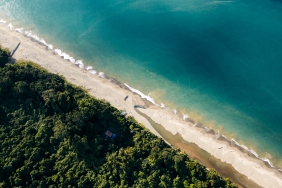#XPDCALORFLOTIM RESULTS: MOST CORAL FRAGMENTS FOUND IN SAP UTILIZATION ZONE OF PANTAR STRAIT, ALOR
"By: Amkieltiela (Marine Science and Knowledge Management Officer, WWF-Indonesia)
Coral reef ecosystem health is one of the indicators of the effectiveness of the management of a conservation area that needs to be done routinely every 2-3 years. Therefore, on March 23-29, 2017, WWF-Indonesia conducted coral reef health observations in collaboration with the East Flores Regency Marine and Fisheries Service, Alor Regency Marine and Fisheries Service, Muhammadiyah Kupang University, UNICONSUFISH, and Reef Check Indonesia Foundation in the waters of the Pantar Strait Waters Nature Reserve and Surrounding Sea (SAP Pantar Strait).
On June 16, 2015, Alor's 276,693.38 hectares Regional Marine Protected Area (MPA) was officially designated as the Pantar Strait and Surrounding Sea Natural Reserve (SAP), through KEPMEN KP No. 35/2015.
In 2014, WWF-Indonesia together with a number of partners have been monitoring the health of coral reef ecosystems in the Pantar Strait SAP and East Flores SAP, to take baseline data.
This observation in 2017 collected repetition data (T1) after collecting baseline data in 2014.
The team successfully collected data from 42 points spread inside and outside the Pantar Strait SAP. These observations were wrapped in one big activity titled Expedition Alor Flotim (#XPDCALORFLOTIM) which was held from March 20 to April 6, 2017.
Condition of Pantar Strait SAP Coral Reef Ecosystem is Still Good, But Coral Fragments Found Highest in Utilization Zone
The observation results show that the condition of the coral reef ecosystem in the Pantar Strait SAP is still in good condition, but coral fragments are found highest in the utilization zone. This needs to be a concern, because if it is not followed up immediately, the area of coral fragments could expand to the no-take zone.
After three years, there was an increase in fish abundance and biomass inside and outside the Pantar Strait SAP area. The no-take zone was able to reduce coral fractionation by 38% followed by an increase in reef fish abundance. However, the economically important (commercial) fish groups remained stable for 3 years which may be due to the current status of fisheries utilization.
To improve the effectiveness of conservation area management, we recommend increasing patrols and law enforcement, expanding the socialization of zoning rules, and drafting a harvest control rule regulation so that it can provide optimal benefits for the surrounding community.
Detailed information especially about the methods and results of the analysis can be read in this report, while the details of the activities can be seen at www.wwf.or.id/xpdcalorflotim.
Read More: XPDCALORFLOTIM Results: Coral Reef Ecosystem Condition in East Flores Waters Nature Reserve Improves
"





